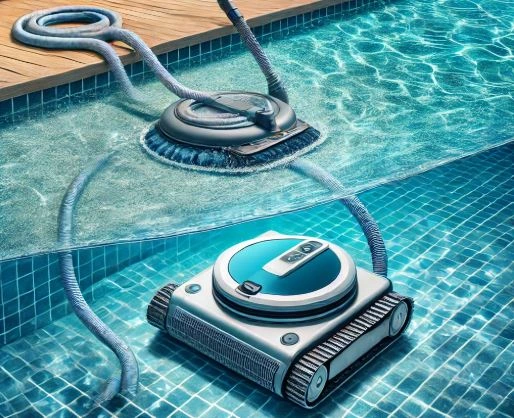Hose Pool Cleaner vs. Robotic Pool Cleaner: Which is Better?

Owning a swimming pool comes with the responsibility of keeping it clean. A well-maintained pool ensures a safe and enjoyable experience. When it comes to pool cleaning, two popular options are hose pool cleaners and robotic pool cleaners. But which one is better? In this blog, we’ll compare both types based on functionality, efficiency, cost, maintenance, and other key factors to help you make the right choice.
What is a Hose Pool Cleaner?
A hose pool cleaner is a suction-based cleaning device that connects to your pool’s skimmer or dedicated suction line. It relies on the pool’s filtration system to remove debris, dirt, and algae from the pool floor and walls. These cleaners operate through water pressure and typically move in a random pattern.
Pros of Hose Pool Cleaners
1. Affordable Option – Hose pool cleaners are generally more budget-friendly than robotic models.
2. Easy to Install – Simply connect the hose cleaner to the skimmer or suction port, and it’s ready to go.
3. Uses Pool’s Filtration System – No need for an additional power source, as it runs using the pool pump.
4. Effective for Fine Debris – Works well for collecting dirt, sand, and algae.
Cons of Hose Pool Cleaners
1. Relies on Pool Pump – Since it uses the pool’s filtration system, it may put extra strain on the pump and filter.
2. Limited Cleaning Pattern – Moves randomly, which can lead to missed spots.
3. May Require Frequent Maintenance – Hoses can get tangled, and the filter needs regular cleaning.
What is a Robotic Pool Cleaner?
A robotic pool cleaner is an advanced, self-contained cleaning device that operates independently of the pool’s filtration system. It runs on electricity and has built-in motors, filters, and smart navigation for efficient cleaning.
Pros of Robotic Pool Cleaners
1. Superior Cleaning Performance – Uses advanced suction and brushing technology to remove dirt, leaves, and algae effectively.
2. Energy Efficient – Runs on low-voltage electricity, making it cost-effective in the long run.
3. Smart Navigation – Cleans methodically and covers the entire pool without missing spots.
4. Independent Filtration System – Reduces strain on the pool’s pump and filter.
5. Easy Maintenance – Comes with a self-contained filter basket, making it simple to clean and maintain.
Cons of Robotic Pool Cleaners
1. Higher Initial Cost – More expensive upfront compared to a hose pool cleaner.
2. Requires Electricity – Needs to be plugged into a power source, which might limit portability.
3. Heavier to Handle – Some models can be bulky and difficult to remove from the pool after cleaning.
Key Comparisons: Hose Pool Cleaner vs. Robotic Pool Cleaner
| Feature | Hose Pool Cleaner | Robotic Pool Cleaner |
|---|---|---|
| Cleaning Efficiency | Moderate, may miss spots | High, covers entire pool |
| Energy Usage | Uses pool pump energy | Runs on low electricity |
| Cost | More affordable upfront | Higher initial investment |
| Maintenance | Requires regular filter cleaning | Easier maintenance with built-in filter |
| Setup & Installation | Simple to connect to skimmer | Plug-and-play setup |
| Pool Pump Dependency | Relies on pool’s filtration system | Works independently |
Which Pool Cleaner Should You Choose?
The choice between a hose pool cleaner and a robotic pool cleaner depends on several factors:
1. Budget – If you’re looking for a low-cost option, a hose pool cleaner is a practical choice.
2. Cleaning Performance – For superior and automated cleaning, a robotic pool cleaner is the best option.
3. Pool Size – If you have a large pool, a robotic cleaner offers better coverage and efficiency.
4. Maintenance Preference – If you prefer a low-maintenance solution, a robotic cleaner is more convenient.
Both hose pool cleaners and robotic pool cleaners have their pros and cons. If you’re looking for a cost-effective, easy-to-install solution, a hose pool cleaner is a great choice. However, if you want an advanced, energy-efficient, and highly effective cleaner, a robotic pool cleaner is worth the investment.
Ultimately, the best option depends on your budget, pool size, and cleaning needs. Whichever you choose, keeping your pool clean ensures a refreshing and enjoyable swimming experience.


